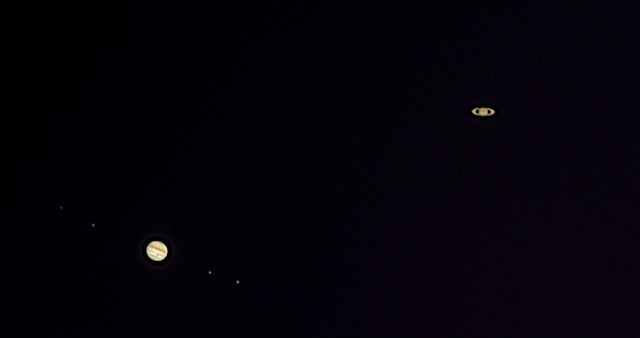Science Snippet:
Explore Saturn

Saturn is currently 824 million miles from the Earth. Over the next few weeks, it will come within 816 million miles before receding again. For Saturn, this is fairly close; at times, it is more than a billion miles away! Still, 824 million miles is a very long distance. In my last article on Jupiter, we visualized distances by imagining that miles were inches. Using this scale, it would take 900 steps to walk all the way around the Earth at the equator. What if we tried to walk the distance to Saturn (if all miles suddenly became inches)? That would be 27.3 million steps. At a realistic walking speed, it would take 21 months to take that many steps. Of course, you can’t actually walk to Saturn in 21 months. For one thing, there isn’t anything to walk on, and there isn’t any air to breathe beyond our atmosphere. Even ignoring those obvious problems, walking the actual distance to Saturn would take 113,000 years.
Even though Saturn is so far away, it is still brighter than most stars in the sky. Saturn is the second largest planet in our solar system. In fact, 700 planets the size of Earth would fit inside Saturn. But even though Saturn is large, it has a very low density. It probably has a small rocky core, but it is mostly composed of hydrogen, with trace amounts of other gases such as helium. This hydrogen is in different forms. Directly above Saturn’s core is a shell of hydrogen metals. A vast ocean of liquid hydrogen surrounds the hydrogen metal. The outer parts of Saturn are composed of hydrogen gas. Saturn rotates very quickly. Its fast rotation, combined with its low density, has made Saturn flatten considerably at its poles and bulge at its equator, creating a shape known as an oblate spheroid. All planets, even the Earth, are oblate spheroids rather than perfect spheres, but Saturn’s shape is the most pronounced.
Saturn is surrounded by a cloud of billions of tiny particles. These particles have formed a large system of rings around the planet. Scientists aren’t sure how Saturn’s rings formed. They may have formed when a comet approached Saturn and was torn apart by the planet’s powerful gravity. Although Saturn’s rings are very wide, in places they are only 30 feet thick. When the edge of Saturn’s rings faces us, we can’t see them because they are so thin. From our point of view, Saturn’s rings go from very wide to invisible on a 25-year cycle as our position relative to Saturn changes. To visualize this, imagine that you are looking at a piece of paper from across a room. It is much harder to see the piece of paper if you are looking at its edge than if you are looking at its surface.
Saturn has 146 moons. New moons are still being discovered. In fact, 63 of those 146 were just announced this year. Seven of Saturn’s moons are large enough to be round. One of these moons, the moon Titan, is larger than our moon. In fact, Titan is larger than the planet Mercury. It is the second-largest moon in our solar system after Jupiter’s largest moon Ganymede. Unlike other moons, Titan has a thick atmosphere rich in nitrogen. Apart from Titan, Earth is the only other body in the solar system with a nitrogen-rich atmosphere. Titan’s atmosphere, however, is almost entirely nitrogen whereas Earth’s atmosphere is only 78% nitrogen. Titan has clouds—but unlike Earth’s clouds, they are formed of methane droplets. In fact, Titan has a complete methane cycle that functions just like the water cycle on Earth, complete with methane rain, methane rivers, and methane lakes or seas. The flowing rivers of methane have carved canyons and gullies on Titan’s surface.
Saturn is visible for most of the night right now. In the evening, Saturn will be low in the southeast while it will appear in the southwest in the morning. It’s best seen about 30 minutes before sunrise. At that point, it will be the only object visible in the southwestern sky. It should appear slightly yellow. Later in the month, Saturn will be easiest to see when it is fully dark. The only bright star near Saturn is Fomalhaut in the constellation Piscis Austrinus. Fomalhaut is much lower than Saturn and is blue-white rather than yellow. In addition, stars twinkle whereas planets do not.
If you have a large pair of binoculars or a small telescope, you can try to find Saturn’s rings. But even a standard pair of binoculars should show that Saturn is not just a ball but is strangely elongated. Saturn’s rings will become harder and harder to find as we will see their edge in 2025. Some people have found Titan with large binoculars and some of the other moons with small telescopes. I have never seen any of Saturn’s moons. But if you want to try, you can use this tool from Sky and Telescope to find the positions of Saturn’s moons. Look in those positions for dim stars that should move in relation to Saturn, as well as nearby stars, from night to night.
Once you’ve found Saturn, you can find it in roughly the same position for several years. Saturn travels around the sun only once every 29.5 years. In our sky, it appears to move through one constellation of the zodiac roughly every two years. But if you watch Saturn over a long enough time period, you will eventually find it in entirely new parts of the sky. If you look for it 29 years from now, you will see it in exactly the same place as you see it now.
